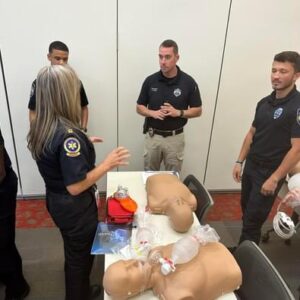Sponsored by East Baton Rouge Emergency Medical Services
Sudden Cardiac Arrest (SCA) is a life-threatening emergency that can happen to anyone, anywhere, at any time. In fact, SCA claims one life every 90 seconds in the United States. As October is Sudden Cardiac Arrest Awareness Month, East Baton Rouge Emergency Medical Services would like to educate the public on recognizing the warning signs, understanding the risk factors and knowing how to respond in a cardiac emergency. Your quick action could be the difference between life and death.
Understanding Sudden Cardiac Arrest
SCA is the sudden loss of all heart activity due to an irregular heart rhythm. When this occurs, breathing stops and the person becomes unconscious. Without immediate treatment, SCA can lead to death.
Emergency treatment for SCA includes cardiopulmonary resuscitation (CPR) and shocks to the heart with a device called an automated external defibrillator (AED). Survival is possible with fast, appropriate medical care. Nine out of 10 cardiac arrest victims who receive a shock from an AED within the first minute live, and a person’s chance of survival while waiting for emergency medical services during a cardiac emergency decreases by 10 percent every minute without CPR.
With that in mind, EBR EMS promotes citizen CPR and works to educate the community about the importance of learning how to perform CPR correctly and what to do if someone collapses in front of you. EMS regularly participates in health fairs and goes out to local schools to demonstrate how to perform CPR correctly.
It’s important to note that if you contact 9-1-1 because someone is in cardiac arrest, the emergency communications officer that answers the call will give you step-by-step instructions on starting CPR immediately.
Know the Risk Factors:
While SCA can affect anyone, certain factors can increase the risk, including having an irregular heart rhythm, underlying heart conditions, recreational drug use, certain medications, physical exertion or stress.
What to do in a Cardiac Emergency
- Check to see if the person is responsive.
- Activate EMS by calling 9-1-1.
- If you are in a public place, look for an AED and turn it on. Follow the prompts.
- Start CPR immediately by placing both hands on the center of the chest and pushing hard and fast. Compressions should be 2-inches deep at a rate of 100-120 compressions per minute.
- Continue CPR until first responders arrive to take over care.
This October, help EBR EMS spread the word about Sudden Cardiac Arrest and the importance of being prepared. By recognizing the warning signs, understanding the risk factors and knowing how to respond in an emergency, you could save a life. For more information about EBR EMS, visit online at https://www.brla.gov/EMS.